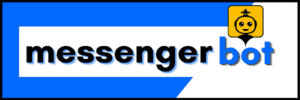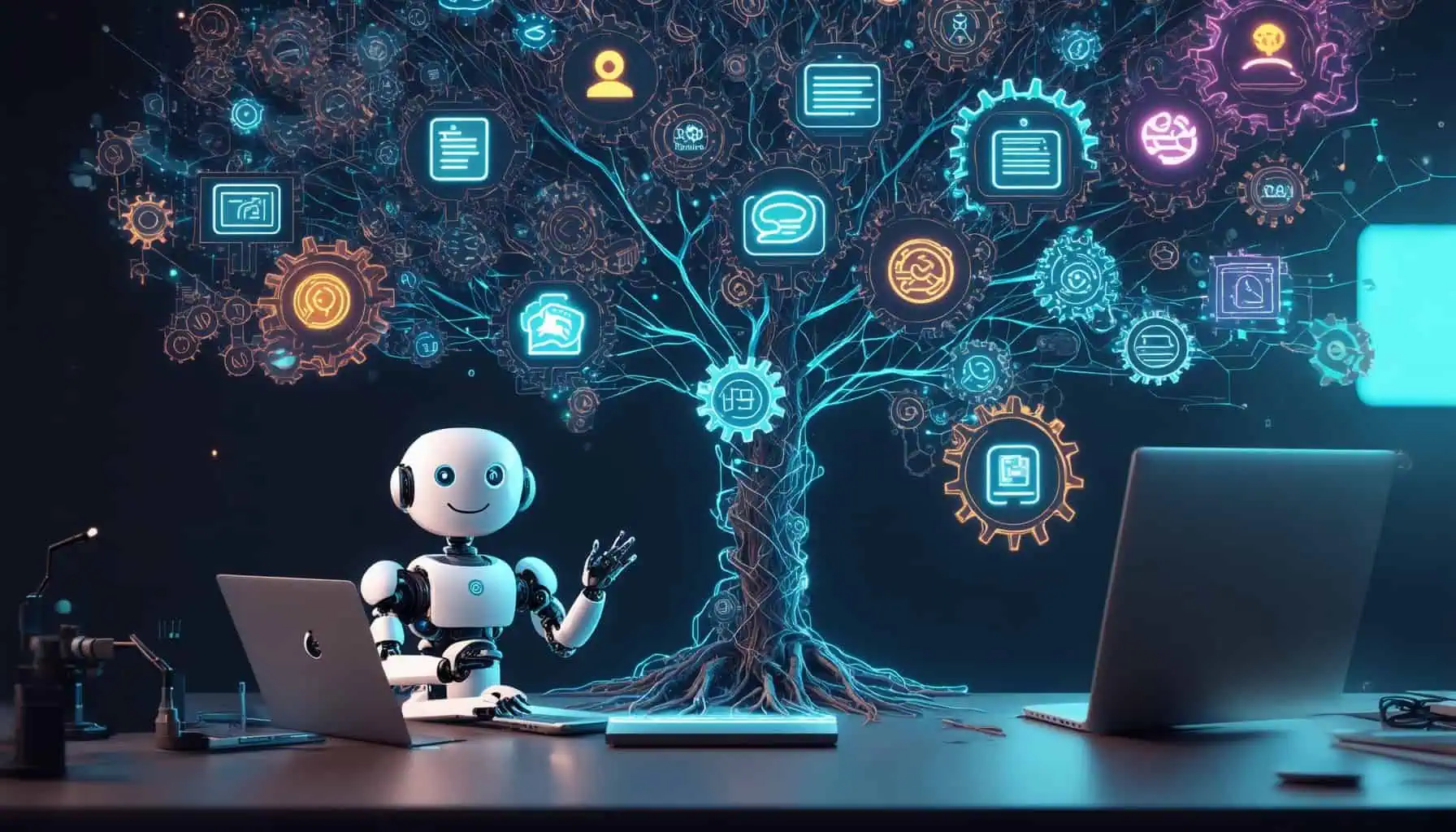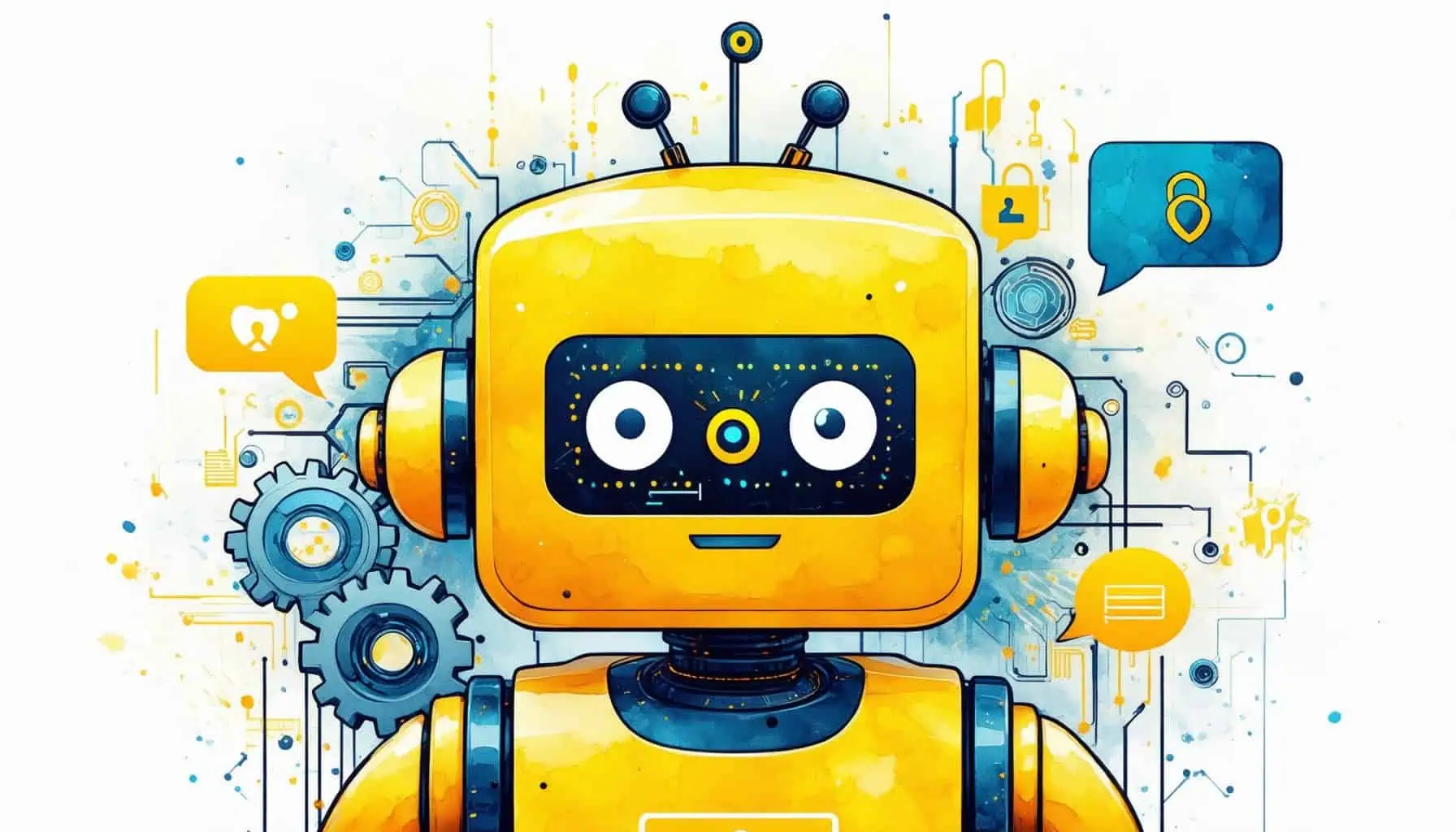Key Takeaways
- Explore top chatbot development tools like Dialogflow and Microsoft Bot Framework for effective customer engagement.
- Utilize free chatbot platforms such as Chatfuel and ManyChat to automate interactions without financial commitment.
- Understand the three types of chatbots: Rule-Based, AI-Powered, and Hybrid to choose the right solution for your needs.
- Follow a structured approach to develop chatbots, including defining purpose, designing conversation flow, and continuous tuning.
- Leverage open-source frameworks like Rasa and Botpress for customizable chatbot solutions tailored to your business requirements.
In today’s digital landscape, chatbot development tools have become essential for businesses looking to enhance customer engagement and streamline operations. This comprehensive guide will delve into the most effective tools and frameworks available for building chatbots, ensuring you have the insights needed to make informed decisions. We will explore the best chatbot development tools for 2023, including both free options and popular software choices, while also addressing common constraints faced during development. Additionally, you’ll learn how to develop a chatbot step-by-step and evaluate the various frameworks available, such as Botpress, to determine which is best suited for your needs. By understanding the three types of chatbots and the role of AI, including the capabilities of ChatGPT, you will be well-equipped to navigate the evolving world of chatbot technology. Join us as we uncover the key takeaways and future trends in chatbot development tools, empowering you to create effective and engaging chatbots.
Best Chatbot Development Tools for 2023
When it comes to developing chatbots, several platforms stand out for their capabilities in creating effective conversational AI. Here’s a comprehensive overview of the top tools commonly used for chatbot development:
- Dialogflow: Developed by Google, Dialogflow is a powerful natural language processing (NLP) platform that allows developers to create conversational interfaces for websites, mobile applications, and messaging platforms. It supports multiple languages and integrates seamlessly with Google Assistant, making it a popular choice for businesses looking to enhance customer engagement.
- Microsoft Bot Framework: This framework provides a comprehensive environment for building, testing, and deploying chatbots. It offers integration with various Microsoft services and supports multiple channels, including Skype, Slack, and Facebook Messenger, allowing developers to reach a wider audience.
- IBM Watson Assistant: Known for its advanced AI capabilities, IBM Watson Assistant enables developers to create chatbots that can understand and respond to user queries effectively. It offers robust analytics and can be integrated with various platforms, enhancing its utility for businesses.
- Chatfuel: Specifically designed for Facebook Messenger, Chatfuel allows users to create chatbots without any coding knowledge. Its user-friendly interface and templates make it accessible for marketers and small businesses looking to automate customer interactions on social media.
- ManyChat: Another popular tool for Facebook Messenger, ManyChat focuses on marketing automation. It allows businesses to create interactive chatbots that can engage users through personalized messages and automated responses, driving conversions and customer satisfaction.
- Rasa: An open-source framework, Rasa is ideal for developers looking for flexibility and control over their chatbot’s functionality. It allows for the creation of highly customizable chatbots that can be trained on specific datasets, making it suitable for complex applications.
- Tidio: Tidio combines live chat and chatbot functionalities, making it a versatile tool for customer support. It integrates with various e-commerce platforms and provides real-time assistance to users, enhancing the overall customer experience.
- Botpress: This open-source platform is designed for developers who want to build chatbots with a focus on customization and control. Botpress offers a visual interface and supports various integrations, making it suitable for businesses with specific needs.
- Zendesk Chat: Formerly known as Zopim, Zendesk Chat provides a robust solution for customer support chatbots. It integrates with the Zendesk support suite, allowing businesses to streamline their customer service operations.
- Landbot: This platform allows users to create conversational experiences through a visual interface, making it easy to design chatbots for websites and messaging apps. Landbot focuses on user engagement and can be used for lead generation and customer support.
In conclusion, the choice of chatbot development platform largely depends on the specific needs of the business, including the desired level of customization, integration capabilities, and target audience. By leveraging these tools, companies can significantly enhance their customer interactions and streamline communication processes. For further insights, refer to resources like Gartner’s reports on AI in customer service and industry blogs that discuss the latest trends in chatbot technology.
Free Chatbot Development Tools: A Comprehensive Overview
For businesses looking to explore chatbot development without a financial commitment, several free tools offer robust functionalities:
- Chatfuel: As mentioned earlier, Chatfuel allows users to create Facebook Messenger bots without coding. Its free plan provides essential features for small businesses to automate responses and engage customers effectively.
- ManyChat: ManyChat also offers a free tier, enabling users to build chatbots for Facebook Messenger with basic automation capabilities. This is ideal for marketers seeking to enhance their social media engagement.
- Rasa: Rasa’s open-source framework allows developers to create custom chatbots for free, offering extensive flexibility and control over the bot’s functionality.
- Tidio: Tidio provides a free plan that combines live chat and chatbot features, making it a great option for businesses wanting to improve customer support without upfront costs.
These free chatbot development tools can help businesses test the waters of automation and customer engagement, allowing them to scale up as needed. For more information on how to set up your first AI chatbot, check out our step-by-step guide.

How to Develop a Chatbot?
To develop a chatbot, follow these comprehensive steps:
- Define the Purpose: Clearly outline the objectives of your chatbot. Determine whether it will provide customer support, facilitate transactions, or engage users in conversation.
- Choose the Right Platform: Select a platform that suits your needs. Options include standalone chatbot frameworks like Dialogflow, Microsoft Bot Framework, or integration with messaging services such as Facebook Messenger.
- Design the Conversation Flow: Map out the user journey and create a flowchart that outlines potential user interactions. This will help in structuring responses and anticipating user needs.
- Develop the Chatbot:
- Use Your Website URL: Integrate the chatbot into your website by embedding it using the provided URL.
- Set Up the Chatbot: Utilize the chosen platform’s tools to create the bot, inputting the conversation flow and responses.
- Train the Chatbot: Input sample questions and answers to help the bot learn from user interactions. Use machine learning techniques to improve its understanding over time.
- Tune Your Chatbot: Continuously refine the bot’s responses based on user feedback and interaction data. Adjust the algorithms to enhance accuracy and relevance.
- Testing Tool: Implement a testing phase where you simulate user interactions to identify any issues. Use analytics to track performance metrics such as response time and user satisfaction.
- Create and Configure Your Chat Widget: Design a user-friendly chat widget that matches your website’s aesthetics. Ensure it is easily accessible to users.
- Customize Your Chat Widget: Add personalized greetings and responses to enhance user engagement. Tailor the bot’s personality to align with your brand voice.
- Set Up Greetings: Program initial greetings that welcome users and guide them on how to interact with the chatbot effectively.
- Preview the Chat Widget: Before launching, preview the chat widget to ensure it functions correctly across different devices and browsers.
For further insights into chatbot development, consider reviewing resources from authoritative sources such as the Journal of Artificial Intelligence Research and industry blogs like Chatbots Magazine, which provide in-depth analysis and case studies on effective chatbot strategies.
Common Constraints in Chatbot Development Tools
While developing chatbots can be highly beneficial, there are several constraints to consider:
- Limited Understanding of Context: Many chatbot development tools struggle with understanding nuanced user queries, which can lead to miscommunication.
- Integration Challenges: Integrating chatbots with existing systems and platforms can be complex, requiring technical expertise and resources.
- Maintenance and Updates: Regular updates and maintenance are essential to keep the chatbot functioning effectively, which can be resource-intensive.
- User Acceptance: Some users may be hesitant to interact with chatbots, preferring human interaction instead, which can limit the effectiveness of the tool.
To explore more about chatbot functionalities and how to overcome these constraints, check out our features page for detailed insights.
What Software is Used for Chatbots?
When it comes to chatbot development tools, selecting the right software is crucial for creating effective and engaging chatbots. In 2025, several platforms stand out for their capabilities in enhancing customer engagement and streamlining communication. Here’s a look at the top software options for chatbot development:
Top Software Options for Chatbot Development
- Dialogflow: Developed by Google, Dialogflow is a powerful natural language processing (NLP) platform that enables developers to create conversational interfaces for various applications. It supports voice and text-based interactions and integrates seamlessly with Google Assistant, making it a popular choice for businesses looking to enhance customer engagement.
- Microsoft Bot Framework: This comprehensive framework allows developers to build, test, and deploy chatbots across multiple channels, including Skype, Slack, and Facebook Messenger. Its integration with Azure Cognitive Services provides advanced AI capabilities, such as sentiment analysis and language understanding.
- IBM Watson Assistant: Known for its robust AI capabilities, IBM Watson Assistant helps businesses create intelligent chatbots that can understand and respond to customer inquiries effectively. It offers features like context management and can be integrated with various platforms, enhancing user experience.
- Chatfuel: A user-friendly platform primarily for Facebook Messenger, Chatfuel allows businesses to create chatbots without any coding knowledge. It offers templates and a visual interface, making it accessible for marketers looking to automate customer interactions.
- ManyChat: Focused on marketing automation, ManyChat enables users to build chatbots for Facebook Messenger and SMS. It provides tools for creating engaging conversations and automating marketing campaigns, making it ideal for businesses looking to drive sales through chat.
- Tidio: Tidio combines live chat and chatbot functionalities, allowing businesses to engage with customers in real-time. Its AI-driven chatbots can handle common inquiries, freeing up human agents for more complex issues.
- Zendesk Chat: This platform integrates chatbots into the customer support workflow, allowing businesses to provide instant responses to customer queries. Its analytics tools help track performance and improve customer satisfaction.
- LivePerson: LivePerson offers AI-powered chatbots that can engage customers across various messaging platforms. Its focus on conversational commerce helps businesses drive sales through personalized interactions.
- Rasa: An open-source framework, Rasa allows developers to build highly customizable chatbots. It emphasizes machine learning and NLP, enabling businesses to create tailored conversational experiences.
- Botpress: Another open-source option, Botpress provides a visual interface for building chatbots. It focuses on developer-friendly features and allows for extensive customization, making it suitable for businesses with specific needs.
These chatbot software solutions are designed to enhance customer engagement and streamline communication processes. By leveraging advanced AI technologies and user-friendly interfaces, businesses can improve their customer service and drive better results in 2025. For more detailed insights, refer to sources like Gartner’s Magic Quadrant for Conversational AI and industry reports from Forrester Research.
Comparing Free Chatbot Platforms
For businesses looking to explore chatbot development without a financial commitment, several free chatbot platforms offer robust features. Here’s a comparison of some of the best free options available:
- Chatfuel: Offers a free tier that allows users to create basic chatbots for Facebook Messenger. It’s ideal for small businesses and marketers who want to automate customer interactions without coding.
- ManyChat: Provides a free plan with essential features for building chatbots on Facebook Messenger and SMS. It’s user-friendly and perfect for marketing automation.
- Tidio: Offers a free version that combines live chat and chatbot functionalities, making it a versatile option for businesses wanting to engage customers in real-time.
- Botpress: As an open-source platform, Botpress allows developers to create chatbots for free, focusing on customization and advanced features.
These free chatbot platforms enable businesses to experiment with chatbot development tools and enhance customer engagement without upfront costs. For more information on how to set up your first AI chatbot, check out our step-by-step guide.
Which Framework is Best for Chatbots?
When considering the best frameworks for chatbots in 2025, several open-source platforms stand out due to their features, flexibility, and community support. Here’s a comprehensive list of the top frameworks:
- Rasa: An open-source framework that excels in natural language understanding (NLU) and dialogue management. Rasa allows developers to create highly customizable chatbots and is particularly strong in handling complex conversations. Its active community and extensive documentation make it a preferred choice for many developers. Source
- Botpress: Known for its user-friendly interface, Botpress is a powerful open-source platform that combines visual flow design with code flexibility. It supports multiple channels and offers built-in analytics, making it ideal for businesses looking to optimize user interactions. Source
- Microsoft Bot Framework: This comprehensive framework provides tools for building, testing, and deploying chatbots across various platforms. It integrates seamlessly with Azure services, enabling advanced functionalities like AI and machine learning capabilities. Source
- Wit.ai: Owned by Facebook, Wit.ai is a natural language processing platform that allows developers to build conversational interfaces. It is particularly useful for integrating chatbots with Facebook Messenger, making it a popular choice for businesses targeting social media engagement. Source
- Botkit: A toolkit for building chatbots that can integrate with various messaging platforms. Botkit is known for its flexibility and ease of use, allowing developers to create bots quickly while still providing the option for advanced customization. Source
- OpenDialog: This framework focuses on creating conversational experiences that are context-aware. OpenDialog is designed for developers who want to build complex, multi-turn conversations and is particularly useful in enterprise settings. Source
- Botonic: A framework that allows developers to create chatbots using React, Botonic is ideal for those familiar with JavaScript. It supports rich media interactions and is designed for building conversational UIs that can be deployed across various channels. Source
- HubSpot: While primarily known as a marketing platform, HubSpot offers chatbot capabilities that integrate with its CRM. This makes it an excellent choice for businesses looking to enhance customer service and lead generation through automated conversations. Source
In summary, the best framework for chatbots depends on your specific needs, such as ease of use, customization, and integration capabilities. Rasa and Botpress are particularly strong contenders for developers seeking robust solutions, while Microsoft Bot Framework offers extensive support for enterprise applications.
Botpress: A Leading Chatbot Development Tool
Botpress stands out as a leading chatbot development tool due to its unique combination of user-friendliness and powerful features. It allows developers to create sophisticated chatbots with minimal coding, making it accessible for both beginners and experienced developers alike. The platform’s visual flow builder simplifies the design process, enabling users to map out conversations intuitively.
Additionally, Botpress supports multiple messaging channels, ensuring that your chatbot can engage users wherever they are. With built-in analytics, you can track user interactions and optimize your chatbot’s performance over time. This makes Botpress not just a tool for development, but a comprehensive solution for enhancing user engagement and satisfaction.
For those interested in exploring Botpress further, you can find more information on their official website: Botpress.

What are the three types of chatbots?
Understanding the types of chatbots is crucial for selecting the right chatbot development tools for your needs. There are three primary types of chatbots, each serving distinct purposes and functionalities:
- Rule-Based Chatbots: These chatbots operate on predefined rules and scripts. They follow a decision tree structure, responding to specific keywords or phrases. While they can handle straightforward queries effectively, their limitations arise when faced with complex or unexpected questions. Rule-based chatbots are often used in customer service for FAQs and basic troubleshooting.
- AI-Powered Chatbots: Utilizing natural language processing (NLP) and machine learning, AI-powered chatbots can understand and respond to user inquiries more dynamically. They learn from interactions, improving their responses over time. These chatbots are capable of handling more complex conversations and can provide personalized experiences. They are commonly found in applications like virtual assistants and customer support platforms.
- Hybrid Chatbots: Combining the features of both rule-based and AI-powered chatbots, hybrid chatbots offer a versatile solution. They can handle simple queries through predefined rules while also leveraging AI capabilities for more complex interactions. This type of chatbot is particularly effective in environments where both structured and unstructured data are present, allowing for a seamless user experience.
Choosing the Right Chatbot Type for Your Needs
When selecting a chatbot type, consider the specific requirements of your business and the interactions you wish to automate. For simple tasks and FAQs, a rule-based chatbot may suffice. However, if you anticipate more complex interactions, investing in AI-powered or hybrid chatbots could enhance user experience significantly.
For further insights on chatbot technology, consider exploring resources from the Brain Pod AI, which provides comprehensive tools and services for chatbot development, including multilingual support and advanced analytics.
Which Tool is Commonly Used to Develop Chatbots?
When it comes to chatbot development tools, several platforms stand out for their capabilities and user-friendliness. Among the most popular are Messenger Bot, Chatfuel, and ManyChat. Each of these tools offers unique features that cater to different business needs, making them ideal for various applications in customer engagement and automation.
Best Chatbot Development Tools for 2023
In 2023, the landscape of chatbot development tools continues to evolve, with several key players leading the charge:
- Messenger Bot: Known for its robust automation capabilities, Messenger Bot excels in managing interactions across multiple channels, including social media and websites. Its AI-driven technology allows for real-time responses and workflow automation, making it a top choice for businesses looking to enhance user engagement.
- Chatfuel: This platform is particularly favored for its ease of use, allowing users to create chatbots without any coding knowledge. Chatfuel provides a visual interface that simplifies the bot-building process, making it accessible for small businesses and startups.
- ManyChat: ManyChat is another popular option, especially for marketing purposes. It integrates seamlessly with Facebook Messenger and offers features like lead generation and automated marketing campaigns, which are essential for businesses aiming to boost their online presence.
Free Chatbot Development Tools: A Comprehensive Overview
For those on a budget, several free chatbot development tools can provide substantial functionality:
- Dialogflow: Developed by Google, Dialogflow offers a free tier that allows users to create conversational interfaces for various platforms. Its natural language processing capabilities make it a powerful tool for developing sophisticated chatbots.
- Botpress: An open-source platform, Botpress is ideal for developers looking for flexibility and customization. It allows users to build chatbots tailored to specific business needs without incurring costs.
- Brain Pod AI: This platform offers a range of AI services, including chatbot development. With its multilingual capabilities and user-friendly interface, Brain Pod AI is a great option for businesses looking to engage a global audience. For more information, visit Brain Pod AI.
Which tool is commonly used to develop chatbots?
When it comes to chatbot development tools, several platforms stand out for their capabilities and user-friendliness. One of the most commonly used tools is Messenger Bot, which leverages artificial intelligence to streamline interactions across various channels. Its automated responses and workflow automation features make it a popular choice among businesses looking to enhance customer engagement. Other notable tools include Chatfuel and ManyChat, which also offer robust functionalities for building chatbots without extensive coding knowledge.
Best Chatbot Development Tools for 2023
As we look into 2023, the landscape of chatbot development tools continues to evolve. Here are some of the best options available:
- Messenger Bot: Known for its seamless integration with social media platforms, Messenger Bot excels in providing automated responses and workflow automation.
- Chatfuel: This tool is particularly favored for its ease of use, allowing users to create bots through a visual interface without coding.
- ManyChat: A strong contender in the market, ManyChat offers extensive features for marketing automation and customer engagement.
- Brain Pod AI: With its advanced AI capabilities, Brain Pod AI provides a comprehensive suite for chatbot development, including multilingual support and analytics. You can explore more about their offerings at Brain Pod AI Homepage.
Free Chatbot Development Tools: A Comprehensive Overview
For those on a budget, several free chatbot development tools can help you get started:
- Messenger Bot Free Trial: Offers a trial period to explore its features without any financial commitment.
- Chatfuel Free Plan: Allows users to create basic bots with limited features, perfect for small businesses or personal projects.
- ManyChat Free Version: Provides essential functionalities for building chatbots, making it accessible for beginners.




